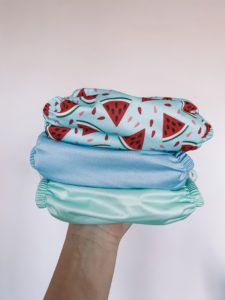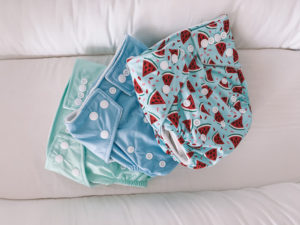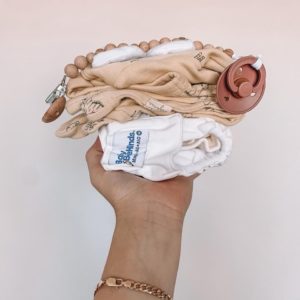It’s a decision every new mama-to-be faces—disposable nappies for the sheer convenience or cloth nappies because it’s more environmentally friendly? When Social Mama discovered the absolutely shocking facts about disposable nappies released by Sustainability Victoria, founder Elisha Fiorentino knew there was only one choice her conscience could make. It was going to be cloth nappies all the way.
Did you know that 3.75 million nappies are used EVERY DAY in Australia and New Zealand? Take a few moments to contemplate that fact. Then think about the fact the one cup of crude oil is used to make each single disposable nappy.
Did you also know that it typically takes 150 years for the typical disposable nappy to break down?
Every time you are tempted to reach for disposable nappies, think that one nappy you throw away will still be decomposing long after both you and your child and and probably your grandchildren have left the planet. But what about biodegradable disposable nappies? They can still take decades to break down. The initial outlay to purchase cloth nappies is more expensive than disposable but the benefits in the long run far outweigh any cost.
The evolution of the cloth nappy
Nappies have come a long way since the early days when parents used animal skins or moss (thank goodness). Even the humble cloth nappy has evolved from when your mother used to change your nappies. For many years, nappies were large squares of linen or cotton that were folded in a particular way and then pinned in place. One had to be an expert to make them stay in place and they required soaking in buckets before washing and then took up the entire clothesline.
Now when it comes to cloth nappies you have choices—multiple choices. Social Mama has done the research so if you’re still trying to weigh up the decision of cloth versus disposable, keep reading. You may just be surprised.
Elisha has trialled two different types of cloth nappies and the findings are below.
Hippybottomus
Winner of the Australian Mother & Baby Cloth Nappy of the Year
How could you not want to buy these simply based on the name alone? This is a straight-forward cloth nappy and easily adjustable for newborns to toddlers—one size fits most. Because they are pocket nappies, there’s not a lot of folding involved and that means they’re easier to put on.
“I got my husband to practice on a few soft toys so he was skilled before our baby arrived.” Elisha said.
They are very practical because the inner lining is quick-drying. Hippybottomus nappies are also designed to reduce irritation. There’s a range of super cute colours and patterns to choose from and Hippybottomus also have swim nappies and training pants. Of course, they’re Australian made and so when you purchase them you’re supporting a local business.



Baby Beehinds
Winner of the Social Mama Cloth Nappy of the Year
Elisha Fiorentino’s top pick.
Not to take anything away from Hippybottomus which are a great brand of cloth nappy, but Social Mama highly recommends the Baby BeeHinds range. These have been a staple in baby Leo’s and Hudson’s nappy wearing lives. Use code SOCIALMAMA15 for 15% off. Baby BeeHinds has trial packs for new mamas. This is so you can try out a variety of styles each of them with different features.
“I just love everything about them! They’re super cute and their variety grows with baby. There are nappies especially designed for newborns, night nappies that are super absorbent and they go right through to training pants.” Elisha said.
The initial outlay to purchase what you need may seem a little expensive, but when you calculate the cost of cloth nappies versus how much disposable nappies will be used across your babies lifetime, that’s a significant saving.
If your newborn used an average of 6 disposable nappies a day, over a week that’s 42 nappies. Any new mum knows it will likely be more than this. Give or take 42 nappies a week x 52 weeks in a year x 2 years—you do the math. That’s a lot of disposable nappies. So, while the initial outlay may be more expensive in the long run cloth nappies are going to save more. With the right care and laundering, your Baby BeeHinds are designed to last for multiple babies.



Caring for Cloth Nappies
“Stop rolling the eyes about all the washing. It’s not that bad once you have a good routine.” Elisha said. Start off by removing any solid and a pre-rinse. Pre-rinse and within 1-2 days carry out a main wash and line-dry, avoiding direct sunlight.
Summary
Elisha hands down loves the Baby BeeHinds nappies and the variety of styles and cute colours they cpme in. “I find them easy to care for and they’re really easy to put on. No folding them origami style like my mum had to or worrying about safety pins. Even my husband can manage to change Leo.”
